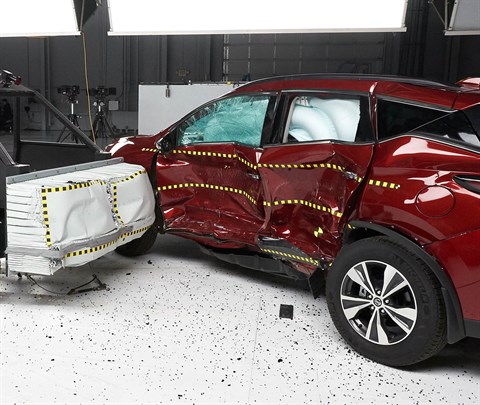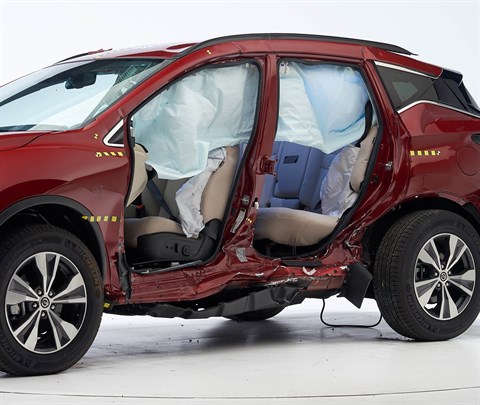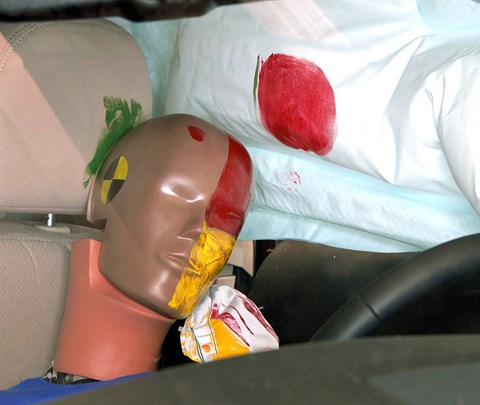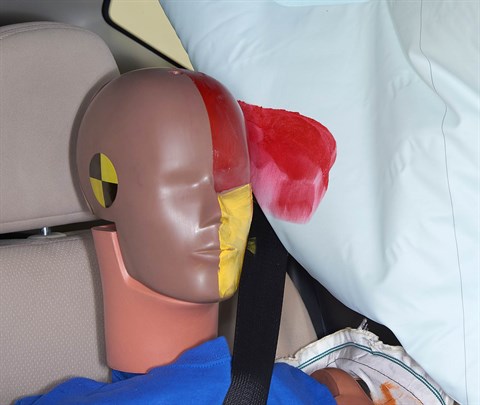Small overlap front: driver-side
Rating applies to 2019-24 models
Tested vehicle: 2019 Nissan Murano SV 4-door 4wd
The Nissan Murano was redesigned for the 2015 model year. Beginning with the 2019 model year, a knee airbag for the front passenger was added, and all of the following airbags were newly designed to improve occupant protection in both moderate overlap and small overlap frontal crashes: driver knee airbag, passenger frontal airbag, and both side curtain airbags.
Driver-side small overlap frontal ratings are assigned by the Institute based on a test conducted by Nissan as part of frontal crash test verification. Because there were no structural changes, the structure rating of the current model is based on this test and an earlier test of a 2015 model conducted by the Institute.
| Overall evaluation | |
|---|---|
| Structure and safety cage | |
| Driver injury measures | |
| Head/neck | |
| Chest | |
| Hip/thigh | |
| Lower leg/foot | |
| Driver restraints and dummy kinematics |
Measures of occupant compartment intrusion on driver side
| Test ID | VTN1911 | CEN1515 |
|---|---|---|
| Lower occupant compartment | ||
| Lower hinge pillar max (cm) | 8 | 13 |
| Footrest (cm) | 5 | 10 |
| Left toepan (cm) | 3 | 3 |
| Brake pedal (cm) | 2 | 6 |
| Parking brake (cm) | 6 | 11 |
| Rocker panel lateral average (cm) | 4 | 6 |
| Upper occupant compartment | ||
| Steering column | 1 | 1 |
| Upper hinge pillar max (cm) | 3 | 7 |
| Upper dash (cm) | 5 | 7 |
| Lower instrument panel (cm) | 6 | 7 |
Driver injury measures
| Test ID | VTN1911 |
|---|---|
| Head | |
| HIC-15 | 89 |
| Peak gs at hard contact | no contact |
| Neck | |
| Tension (kN) | 1.0 |
| Extension bending moment (Nm) | 13 |
| Maximum Nij | 0.21 |
| Chest maximum compression (mm) | 24 |
| Femur (kN) | |
| Left | 0.9 |
| Right | 0.4 |
| Knee displacement (mm) | |
| Left | 1 |
| Right | 0 |
| Knee-thigh-hip injury risk (%) | |
| Left | 0 |
| Right | 0 |
| Maximum tibia index | |
| Left | 0.74 |
| Right | 0.50 |
| Tibia axial force (kN) | |
| Left | 2.0 |
| Right | 0.3 |
| Foot acceleration (g) | |
| Left | 42 |
| Right | 37 |
Small overlap front: passenger-side
Rating applies to 2019-24 models
Tested vehicle: 2019 Nissan Murano SV 4-door 4wd
The Nissan Murano was redesigned for the 2015 model year. Beginning with the 2019 model year, a knee airbag for the front passenger was added, and all of the following airbags were newly designed to improve occupant protection in both moderate overlap and small overlap frontal crashes: passenger frontal airbag, driver knee airbag, and both side curtain airbags.
Passenger-side small overlap frontal ratings are assigned by the Institute based on a test conducted by Nissan as part of frontal crash test verification.
| Overall evaluation | |
|---|---|
| Structure and safety cage | |
| Passenger injury measures | |
| Head/neck | |
| Chest | |
| Hip/thigh | |
| Lower leg/foot | |
| Passenger restraints and dummy kinematics The dummy’s head contacted the frontal airbag but slid off the right side, leaving the head vulnerable to contact with forward structure. The side curtain airbag deployed and has sufficient forward coverage to protect the head from contact with side structure and outside objects. |
|
| Driver injury measures | |
| Head/neck | |
| Chest | |
| Hip/thigh | |
| Lower leg/foot | |
| Driver restraints and dummy kinematics |
Measures of occupant compartment intrusion on passenger side
| Test ID | VTP1923 |
|---|---|
| Lower occupant compartment | |
| Lower hinge pillar max (cm) | 8 |
| Footrest (cm) | 8 |
| Right toepan (cm) | 7 |
| Center toepan (cm) | 5 |
| Rocker panel lateral average (cm) | 2 |
| Upper occupant compartment | |
| Center dash (cm) | 2 |
| Upper hinge pillar max (cm) | 5 |
| Upper dash (cm) | 6 |
| Right lower dash (cm) | 5 |
Passenger injury measures
| Test ID | VTP1923 |
|---|---|
| Head | |
| HIC-15 | 92 |
| Peak gs at hard contact | no contact |
| Neck | |
| Tension (kN) | 0.7 |
| Extension bending moment (Nm) | 17 |
| Maximum Nij | 0.18 |
| Chest maximum compression (mm) | 16 |
| Femur (kN) | |
| Left | 2.2 |
| Right | 0.9 |
| Knee displacement (mm) | |
| Left | 3 |
| Right | 3 |
| Knee-thigh-hip injury risk (%) | |
| Left | 0 |
| Right | 0 |
| Maximum tibia index | |
| Left | 0.41 |
| Right | 0.45 |
| Tibia axial force (kN) | |
| Left | 2.6 |
| Right | 1.9 |
| Foot acceleration (g) | |
| Left | 29 |
| Right | 47 |
Driver injury measures
| Test ID | VTP1923 |
|---|---|
| Head | |
| HIC-15 | 71 |
| Peak gs at hard contact | no contact |
| Neck | |
| Tension (kN) | 1.2 |
| Extension bending moment (Nm) | 11 |
| Maximum Nij | 0.19 |
| Chest maximum compression (mm) | 20 |
| Femur (kN) | |
| Left | 0.6 |
| Right | 0.4 |
| Knee displacement (mm) | |
| Left | 0 |
| Right | 1 |
| Knee-thigh-hip injury risk (%) | |
| Left | 0 |
| Right | 0 |
| Maximum tibia index | |
| Left | 0.38 |
| Right | 0.28 |
| Tibia axial force (kN) | |
| Left | 0.4 |
| Right | 0.3 |
| Foot acceleration (g) | |
| Left | 39 |
| Right | 31 |
How the passenger-side small overlap front test is conducted
Moderate overlap front: original test
Rating applies to 2019-24 models
Tested vehicle: 2019 Nissan Murano SV 4-door 4wd
The Nissan Murano was redesigned for the 2015 model year. Beginning with the 2019 model year, a knee airbag for the front passenger was added, and all of the following airbags were newly designed to improve occupant protection in both moderate overlap and small overlap frontal crashes: driver knee airbag, passenger frontal airbag, and both side curtain airbags.
Moderate overlap frontal ratings are assigned by the Institute based on a test conducted by Nissan as part of frontal crash test verification. Because there were no structural changes, the structure rating of the current model is based on this test and and an earlier test of a 2015 model also conducted by Nissan.
| Overall evaluation | |
|---|---|
| Structure and safety cage | |
| Driver injury measures | |
| Head/neck | |
| Chest | |
| Leg/foot, left | |
| Leg/foot, right | |
| Driver restraints and dummy kinematics |
Measures of occupant compartment intrusion on driver side
| Test ID | VTF1916 | VTF1416 |
|---|---|---|
| Footwell intrusion | ||
| Footrest (cm) | 6 | 8 |
| Left (cm) | 13 | 11 |
| Center (cm) | 7 | 8 |
| Right (cm) | 5 | 7 |
| Brake pedal (cm) | 3 | 1 |
| Instrument panel rearward movement | ||
| Left (cm) | 1 | 2 |
| Right (cm) | 0 | 1 |
| Steering column movement | ||
| Upward (cm) | -4 | 6 |
| Rearward (cm) | -2 | 0 |
| A-pillar rearward movement (cm) | 0 | 1 |
Driver injury measures
| Test ID | VTF1916 | |
|---|---|---|
| Head | ||
| HIC-15 | 166 | |
| Peak gs at hard contact | no contact | |
| Neck | ||
| Tension (kN) | 1.3 | |
| Extension bending moment (Nm) | 21 | |
| Maximum Nij | 0.27 | |
| Chest maximum compression (mm) | 29 | |
| Legs | ||
| Femur force - left (kN) | 0.7 | |
| Femur force - right (kN) | 1.2 | |
| Knee displacement - left (mm) | 2 | |
| Knee displacement - right (mm) | 3 | |
| Maximum tibia index - left | 0.46 | |
| Maximum tibia index - right | 0.47 | |
| Tibia axial force - left (kN) | 1.8 | |
| Tibia axial force - right (kN) | 1.8 | |
| Foot acceleration (g) | ||
| Left | 49 | |
| Right | 50 | |
Side: original test
Rating applies to 2019-24 models
Tested vehicle: 2019 Nissan Murano SL 4-door 4wd
The Nissan Murano was redesigned for the 2015 model year. Beginning with the 2019 model year, side torso airbags were added for outboard rear seat occupants, and both side curtain airbags and front-seat side torso airbags were newly designed to improve occupant protection in side impact crashes.
Side ratings are assigned by the Institute based on a test conducted by Nissan as part of side crash test verification. Because there were no structural changes, the structure rating of the current model is based on this test and and an earlier test of a 2015 model also conducted by Nissan.
| Overall evaluation | |
|---|---|
| Structure and safety cage | |
| Driver injury measures | |
| Head/neck | |
| Torso | |
| Pelvis/leg | |
| Driver head protection | |
| Rear passenger injury measures | |
| Head/neck | |
| Torso | |
| Pelvis/leg | |
| Rear passenger head protection | |
Measures of occupant compartment intrusion on driver side
| Test ID | VTS1918 | VTS1419 |
|---|---|---|
| B-pillar to longitudinal centerline of driver's seat (cm) | -13.0 | -10.5 |
| Negative numbers indicate the amount by which the crush stopped short of the seat centerline. | ||
Driver injury measures
| Test ID | VTS1918 |
|---|---|
| Head HIC-15 | 225 |
| Neck | |
| Tension (kN) | 1.2 |
| Compression (kN) | 1.1 |
| Shoulder | |
| Lateral deflection (mm) | 36 |
| Lateral force (kN) | 1.3 |
| Torso | |
| Maximum deflection (mm) | 35 |
| Average deflection (mm) | 30 |
| Maximum deflection rate (m/s) | 3.30 |
| Maximum viscous criterion (m/s) | 0.56 |
| Pelvis | |
| Iliac force (kN) | 1.0 |
| Acetabulum force (kN) | 1.2 |
| Combined force (kN) | 2.2 |
| Left femur | |
| L-M force (kN) | 0.7 |
| L-M moment (Nm) | 149 |
| A-P moment (Nm) | -36 |
Passenger injury measures
| Test ID | VTS1918 |
|---|---|
| Head HIC-15 | 140 |
| Neck | |
| Tension (kN) | 0.2 |
| Compression (kN) | 0.2 |
| Shoulder | |
| Lateral deflection (mm) | 7 |
| Lateral force (kN) | 0.5 |
| Torso | |
| Maximum deflection (mm) | 14 |
| Average deflection (mm) | 12 |
| Maximum deflection rate (m/s) | 1.76 |
| Maximum viscous criterion (m/s) | 0.05 |
| Pelvis | |
| Iliac force (kN) | 0.3 |
| Acetabulum force (kN) | 1.1 |
| Combined force (kN) | 1.2 |
| Left femur | |
| L-M force (kN) | 1.2 |
| L-M moment (Nm) | 93 |
| A-P moment (Nm) | 18 |
Side: updated test
Rating applies to 2019-24 models
Tested vehicle: 2021 Nissan Murano SV 4-door 4wd
The Nissan Murano was redesigned for the 2015 model year. Beginning with the 2019 model year, side torso airbags were added for outboard rear seat occupants, and both side curtain airbags and front-seat side torso airbags were newly designed to improve occupant protection in side impact crashes.
| Overall evaluation | |
|---|---|
| Structure and safety cage | |
| Driver injury measures | |
| Head/neck | |
| Torso | |
| Pelvis | |
| Driver head protection | |
| Rear passenger injury measures | |
| Head/neck | |
| Torso | |
| Pelvis | |
| Rear passenger head protection | |

View of the vehicle just after the crash test.

View of the vehicle after the crash with doors removed, showing the side airbags and damage to the occupant compartment.

Smeared greasepaint shows where the driver dummy's head was protected from being hit by hard structures by the side airbags.

Smeared greasepaint shows where the rear passenger dummy’s head was protected by the side airbags.
Measures of occupant compartment intrusion on driver side
| Test ID | CES2202 |
|---|---|
| B-pillar to longitudinal centerline of driver's seat (cm) | -7.0 |
| Negative numbers indicate the amount by which the crush stopped short of the seat centerline. | |
Driver injury measures
| Test ID | CES2202 |
|---|---|
| Head | |
| HIC-15 | 286 |
| Peak gs at hard contact | no contact |
| Neck | |
| Tension (kN) | 1.8 |
| Compression (kN) | 0.2 |
| Shoulder | |
| Lateral deflection (mm) | 42 |
| Lateral force (kN) | 1.3 |
| Torso | |
| Maximum deflection (mm) | 43 |
| Average deflection (mm) | 38 |
| Maximum deflection rate (m/s) | 4.14 |
| Maximum viscous criterion (m/s) | 0.76 |
| Pelvis | |
| Combined force (kN) | 5.1 |
Passenger injury measures
| Test ID | CES2202 |
|---|---|
| Head | |
| HIC-15 | 182 |
| Peak gs at hard contact | no contact |
| Neck | |
| Tension (kN) | 0.4 |
| Compression (kN) | 0.5 |
| Shoulder | |
| Lateral deflection (mm) | 16 |
| Lateral force (kN) | 0.8 |
| Torso | |
| Maximum deflection (mm) | 20 |
| Average deflection (mm) | 18 |
| Maximum deflection rate (m/s) | 2.16 |
| Maximum viscous criterion (m/s) | 0.13 |
| Pelvis | |
| Combined force (kN) | 1.5 |
Roof strength
Rating applies to 2015-23 models
Tested vehicle: 2015 Nissan Murano SV 4-door 4wd
| Overall evaluation | |
|---|---|
| Curb weight | 3,904 lbs |
| Peak force | 17,718 lbs |
| Strength-to-weight ratio | 4.54 |
Head restraints & seats
Seat type: Power cloth seat
| Overall evaluation | |
|---|---|
| Dynamic rating | |
| Seat/head restraint geometry |
| Seat type | Power cloth seat |
|---|---|
| Geometry | |
| Backset (mm) | 18 |
| Distance below top of head (mm) | 20 |
| Seat design parameters | |
| Pass/fail | Pass |
| Max T1 acceleration (g) | 12.5 |
| Head contact time (ms) | 63 |
| Force rating | 1 |
| Neck forces | |
| Max neck shear force (N) | 0 |
| Max neck tension (N) | 337 |
How the head restraint & seat test is conducted
Currently, IIHS tests apply only to front seats.
